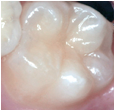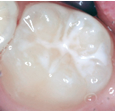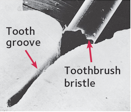Sealants
Our teeth are covered with a sticky film of bacteria, called plaque (sounds like PLAK). When we eat or drink anything that contains sugar-such as cookies, candy, soda, juice, or sports drinks-bacteria turn the sugar into acids that can attack tooth enamel. Over time, these attacks may cause tooth decay, or cavities. The good news is that there is a way to protect teeth and prevent decay: dental sealants.
|
Why are sealants needed?
That is how decay starts in the pits and grooves and cavities form. To keep decay from starting here, the dentist may recommend dental sealants. |
Even a toothbrush bristle is too big to reach inside a groove in the tooth (magnified). |
How do sealants work?
A dental sealant is a plastic material (resin) applied to the chewing surfaces of the back teeth. The sealant material flows into the pits and grooves in the teeth. The sealant acts as a barrier, protecting enamel by sealing out plaque, bacteria, and food.
 Tooth surface before a sealant is applied
Tooth surface before a sealant is applied
 Tooth surface protected by a sealant
Tooth surface protected by a sealant


